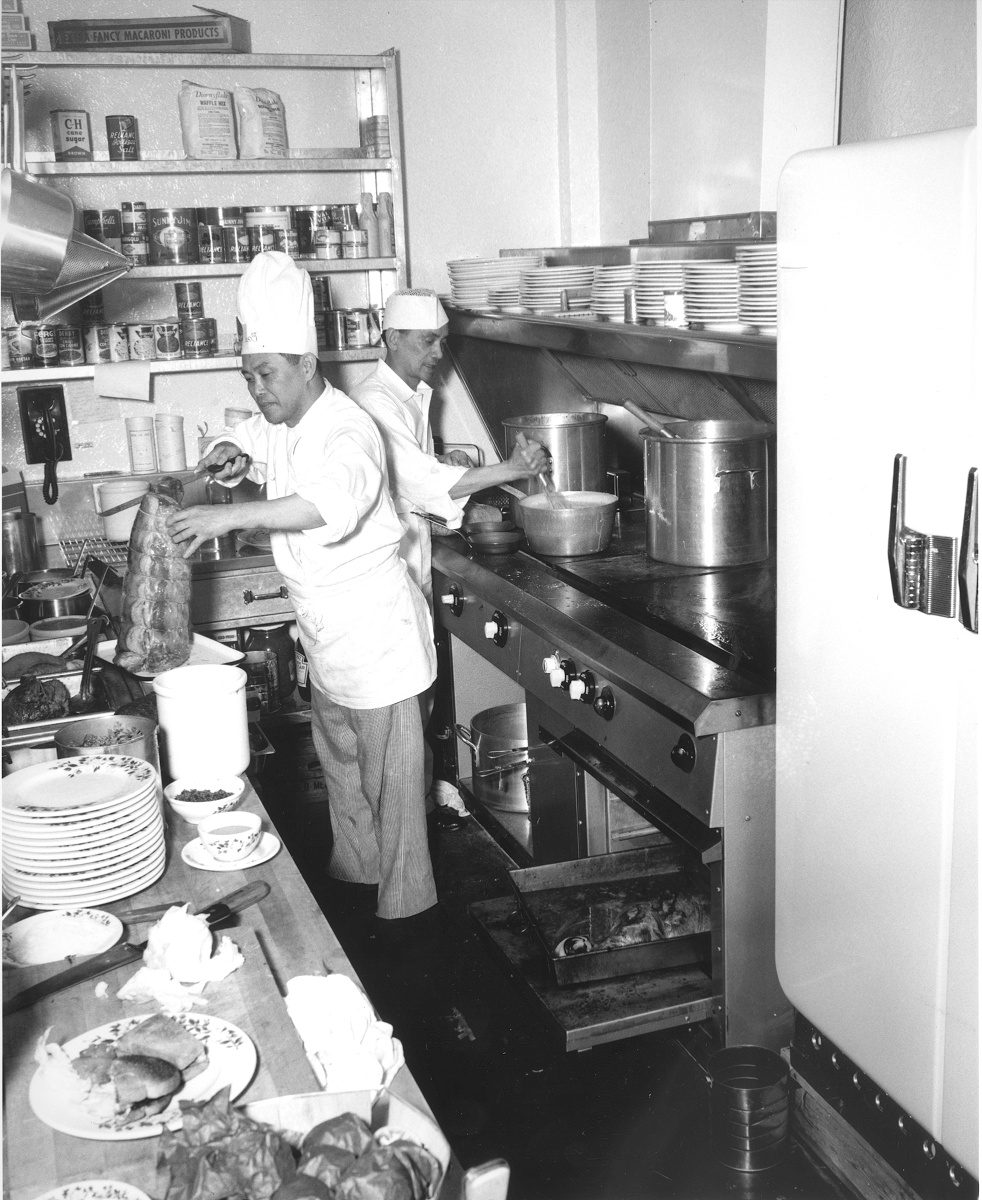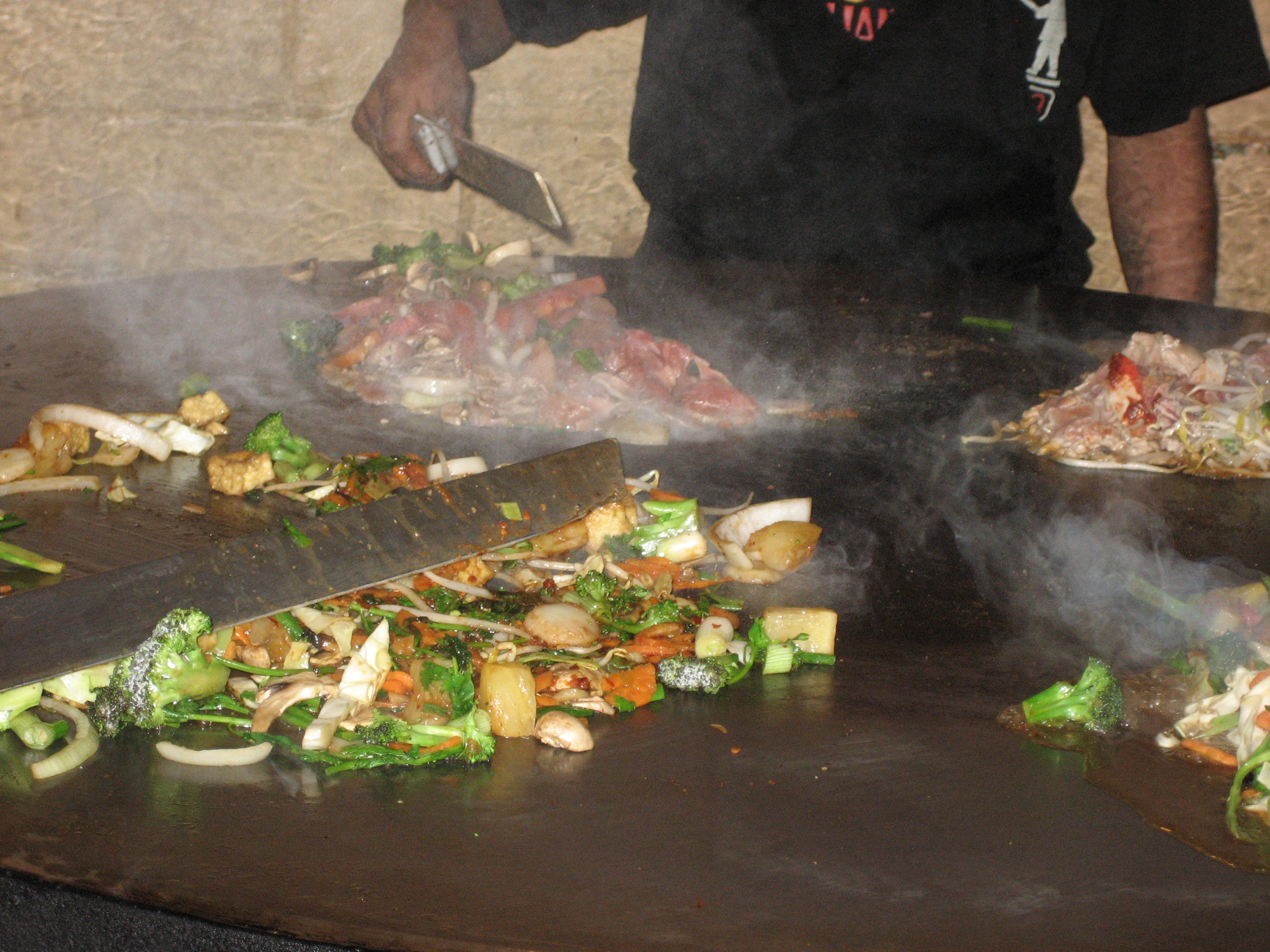|
Teppanyaki
, often confused with , is a post-World War II style of Japanese cuisine that uses an iron griddle to cook food. The word ''teppanyaki'' is derived from ''teppan'' ( 鉄板), the metal plate on which it is cooked, and ''yaki'' ( 焼き), which means grilled, broiled, or pan-fried. In Japan, teppanyaki refers to dishes cooked using a teppan, including steak, shrimp, ''okonomiyaki'', ''yakisoba'' and ''monjayaki''. The ''teppanyaki'' grills are called teppan and are typically propane-heated, flat-surfaced, and are widely used to cook food in front of guests at restaurants. Teppan are commonly confused with the '' hibachi'' barbecue grill, which is called shichirin in Japanese, and has a charcoal or gas flame and is made with an open grate design. With a solid griddle-type cook surface, the ''teppan'' is capable of cooking small or semisolid ingredients such as rice, egg and finely chopped vegetables. Origin The originator of the ''teppanyaki''-style steakhouse is believed to b ... [...More Info...] [...Related Items...] OR: [Wikipedia] [Google] [Baidu] |
Okonomiyaki
is a Japanese savory pancake dish consisting of wheat flour batter and other ingredients (mixed, or as toppings) cooked on a '' teppan'' (flat griddle). Common additions include cabbage, meat, and seafood, and toppings include ''okonomiyaki'' sauce (made with Worcestershire sauce), '' aonori'' (dried seaweed flakes), ''katsuobushi'' (bonito flakes), Japanese mayonnaise, and pickled ginger. ''Okonomiyaki'' is mainly associated with two distinct variants from Hiroshima or the Kansai region of Japan, but is widely available throughout the country, with toppings and batters varying by area. The name is derived from the word , meaning "how you like" or "what you like", and , meaning "grilled". It is an example of ( in the Kansai dialect), or flour-based Japanese cuisine. A liquid-based ''okonomiyaki'', popular in Tokyo, is called ''monjayaki''. Outside of Japan, it can also be found served in Manila, Taipei, Bangkok, and Jakarta by street vendors. History A thin crêp ... [...More Info...] [...Related Items...] OR: [Wikipedia] [Google] [Baidu] |
Flattop Grill
A flattop grill is a cooking appliance that resembles a griddle but performs differently because the heating element is circular rather than straight (side to side). This heating technology creates an extremely hot and even cooking surface, as heat spreads in a radial fashion over the surface. Flattop grills have been around for hundreds of years in various forms and evolved in a number of cultures. History The first flattop grills originated in the 19th century in Mexico and Central America for cooking corn dough. These flattop grills were made of clay. With the arrival of Spaniards, the griddles were manufactured of metal materials. Spaniards adopted these grills with the name ''plancha'', which means "metal plate". Food that is cooked ''a la plancha'' means “grilled on a metal plate”. For example, ''filetes a la plancha'' translates as “grilled beef fillets”. Description The flattop grill is a versatile platform for many cooking techniques such as sautéing, toa ... [...More Info...] [...Related Items...] OR: [Wikipedia] [Google] [Baidu] |
Monjayaki
is a type of Japanese pan-fried batter, popular in the Kantō region, similar to okonomiyaki, but using different liquid ingredients. Ingredients The ingredients in monjayaki are finely chopped and mixed into the batter before frying. Monjayaki batter has ingredients similar to okonomiyaki. However, additional dashi or water is added to the monjayaki batter mixture, making it runnier than okonomiyaki. The consistency of cooked monjayaki is comparable to melted cheese. Diners eat directly from the grill using a small spatula. Monjayaki diners also participate in the cooking by spreading raw monja on the grill so that crispy bits form and caramelize. Many monjayaki restaurants can be found in the Tsukishima district of Tokyo where the dish is said to have originated. Most of these restaurants also serve regular okonomiyaki.Trautlein, Steve,The chow-down tour of Kanto's local dishes, ''The Japan Times'', 24 August 2012, p. 15. See also * Japanese cuisine * Teppanyaki * Okonomiy ... [...More Info...] [...Related Items...] OR: [Wikipedia] [Google] [Baidu] |
Benihana
is an American restaurant company founded by Hiroaki Aoki in New York City in 1964 and currently based in Aventura, Florida. It owns or franchises 116 Japanese-influenced restaurants around the world, including its flagship Benihana Teppanyaki brand, as well as the Haru (fusion cuisine) and RA Sushi restaurants. Benihana introduced the teppanyaki (colloquially known as ''hibachi'') restaurant concept, which had originated in Japan in the late 1940s, to the United States, and later to other countries. History The company was founded in 1964 on West 56th Street in New York City by 25-year-old Hiroaki Aoki, the father of Steve Aoki and Devon Aoki. Aoki, a wrestler who had qualified for but did not attend the 1960 Summer Olympics, started the restaurant with earned from driving an ice cream truck in Harlem. The first restaurant, Benihana of Tokyo, was named for the red safflower that was the name for the coffee shop owned by his parents in Tokyo. Aoki's concept was for ... [...More Info...] [...Related Items...] OR: [Wikipedia] [Google] [Baidu] |
Hibachi
The is a traditional Japanese heating device. It is a brazier which is either round, cylindrical, or box-shaped, open-topped container, made from or lined with a heatproof material and designed to hold burning charcoal. It is believed date back to the Heian period (794 to 1185). It is filled with incombustible ash, and charcoal sits in the center of the ash. To handle the charcoal, a pair of metal chopsticks called is used, in a way similar to Western fire irons or tongs. were used for heating, not for cooking. It heats by radiation, (bibliographic dat and is too weak to warm a whole room, often disappointing foreigners who expected such power. Sometimes, people placed a over the to boil water for Japanese tea, tea. Later, by the 1900s, some cooking was also done over the . Traditional Japanese houses were well ventilated (or poorly sealed), so carbon monoxide poisoning or suffocation from carbon dioxide from burning charcoal were of lesser concern. Nevertheless, ... [...More Info...] [...Related Items...] OR: [Wikipedia] [Google] [Baidu] |
Mongolian Barbecue
Mongolian barbecue () is a Stir frying, stir fried dish that was developed by Wu Zhaonan in Taiwan in 1951. Meat and vegetables are cooked on large, round, solid iron griddles at temperatures of up to 300 °C (572 °F). Despite its name, the dish is not Mongolian cuisine, Mongolian and is only loosely related to barbecue. Origin Mongolian barbecue was created by the Taiwanese comedian and restaurateur Wu Zhaonan. A native of Beijing, Wu fled to Taiwan because of the Chinese Civil War, and opened a street food stall in , Taipei in 1951. He originally wanted to call the dish "Beijing barbecue", but because of political sensitivity with the city, which had just recently been designated as the capital of Communist China, he settled with "Mongolian barbecue" instead, even though it had no direct connection to Mongolia. Wu's food stall became very popular and even attracted foreign diplomats and wealthy business people despite being a cheap eatery. However, it was later d ... [...More Info...] [...Related Items...] OR: [Wikipedia] [Google] [Baidu] |
Griddle
A griddle, in the UK also called a girdle, is a cooking device consisting mainly of a broad, usually flat cooking surface. Nowadays it can be either a movable metal pan- or plate-like utensil, a flat heated cooking surface built into a stove or kitchen range, or a compact cooking machine with its own heating system attached to an integrated griddle acting as a cooktop. A traditional griddle can either be a brick slab or tablet, or a flat or curved metal disc, while in industrialized countries a griddle is most commonly a flat metal plate. A griddle can have both residential and commercial applications, and can be heated directly or indirectly. The heating can be supplied either by a flame fuelled by wood, coal, or gas; or by electrical elements. Commercial griddles run on electricity, natural gas or propane. [...More Info...] [...Related Items...] OR: [Wikipedia] [Google] [Baidu] |
Yakisoba
''Yakisoba'' ( ja, 焼きそば ), "fried noodle", is a Japanese noodle stir-fried dish. Usually, soba noodles are made from buckwheat flour, but soba in yakisoba are Chinese noodles (Chuuka soba) made from wheat flour, typically flavored with a condiment similar to Worcestershire sauce. The dish first appeared in food stalls in Japan around the 1930s. Preparation Yakisoba is prepared by frying ramen-style wheat noodles (also called "Chinese noodles" 中華麺) with bite-sized pork and finely chopped vegetables like cabbage, onions, bean sprouts, and carrots. It is then flavored with yakisoba sauce, salt, and pepper. It can be served with a variety of garnishes, such as '' aonori'' (seaweed powder), '' beni shōga'' (shredded pickled ginger), ''katsuobushi'' (bonito fish flakes), or Japanese-style mayonnaise. Serving Yakisoba is most familiarly served on a plate either as a main dish or a side dish. A more novel way of serving yakisoba in Japan is to pile the noodles in ... [...More Info...] [...Related Items...] OR: [Wikipedia] [Google] [Baidu] |
Soybean Oil
Soybean oil (British English: soyabean oil) is a vegetable oil extracted from the seeds of the soybean (''Glycine max''). It is one of the most widely consumed cooking oils and the second most consumed vegetable oil. As a drying oil, processed soybean oil is also used as a base for printing inks ( soy ink) and oil paints. History Chinese records dating prior to 2000 BCE mention use of cultivated soybeans to produce edible soy oil. Ancient Chinese literature reveals that soybeans were extensively cultivated and highly valued as a use for the soybean oil production process before written records were kept. Production To produce soybean oil, the soybeans are cracked, adjusted for moisture content, heated to between 60 and 88 °C (140–190 °F), rolled into flakes, and solvent-extracted with hexanes. The oil is then refined, blended for different applications, and sometimes hydrogenated. Soybean oils, both liquid and partially hydrogenated are sold as "vegetable oil ... [...More Info...] [...Related Items...] OR: [Wikipedia] [Google] [Baidu] |



.jpg)



.jpg)